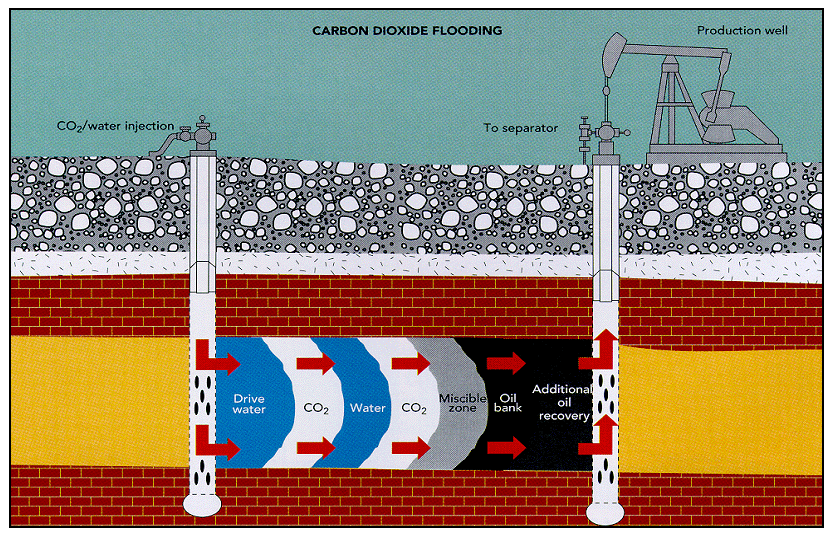







 |
|||||||||||||
 |
|||||||||||||
 |
|||||||||||||
 |
|||||||||||||
 |
|||||||||||||
 |
|||||||||||||
 |
|||||||||||||
 |
|||||||||||||
Long-term storage of CO2 in underground geologic formations has the potential to be viable in the near-term. Many power plants and other large point sources of CO2 emissions are located near geologic formations that are amenable to CO2 storage. Further, in many cases injection of CO2 into a geologic formation can enhance the recovery of oil and gas, which can offset the cost of CO2 capture. The major types of geologic reservoirs that are being investigated for near-term use as CO2 sequestration sinks are:
The use of CO2 to enhance oil and gas recovery is a common industrial practice. CO2 is widely acknowledged as one of the best mediums to use for enhanced oil recovery. In the year 2000 in the United States, 34 million tons of CO2 were injected underground as a part of enhanced oil recovery (EOR) and coal bed methane recovery (E-CBM) operations. This is approximately equivalent to the CO2 emissions from 6 million cars in one year. These injection operations take place in the southwest portion of the US using CO2 produced from naturally occurring geologic reservoirs. Most of the US does not have known large CO2 reservoirs to use for enhanced recovery operations. Thus, application of CO2 capture technology will provide an affordable source of CO2 for enhanced recovery operations that could provide a much-needed stimulus to the oil and gas industry of this region. Nearly a billion barrels of oil may be producible via CO2 enhanced recovery operations within the MIDCARB region alone!

A novel process that currently experiences a broad interest is the injection of CO2 into coalbeds that are not minable, thus releasing the trapped methane. This process is called Enhanced Gas Recovery (EGR) or Enhanced CoalBed Methane production (ECBM), and is similar to the popular practice of using CO2 injection to enhance production from oil reservoirs.
With EGR, the injected CO2 is adsorbed by the coal and stored in the pore matrix of the coal seams, releasing the trapped methane that can be sold for profit. Future work in the area can lead to the design of efficient null-greenhouse-gas-emission power plants that are fueled either by minable coal or by the methane released from the deep coal reservoirs. In this closed CO2 process, the waste CO2 produced from the coal or methane-powered plants is injected into the CBM reservoirs to produce more methane, and the cycle continues.
In addition, a geological sink is established in the coalbeds, virtually eliminating any release of CO2 to the atmosphere.
Saline formations do not contain oil and gas resources and thus do not offer the value-added benefit of enhanced hydrocarbon production. However, the potential CO2 storage capacity of domestic saline formations is huge; estimates are on the order of several hundred years of CO2 emissions.
Disposal of industrial waste fluids in geologic formations is a widely accepted practice; one that is a large part of the solutions that have led to cleaner surface waters in the US and worldwide. Thus, using the deep subsurface saline formations to help cleanse our biosphere is not a new concept.
Home ||
Map
Interface ||
Calculators ||
Reports ||
Contacts
